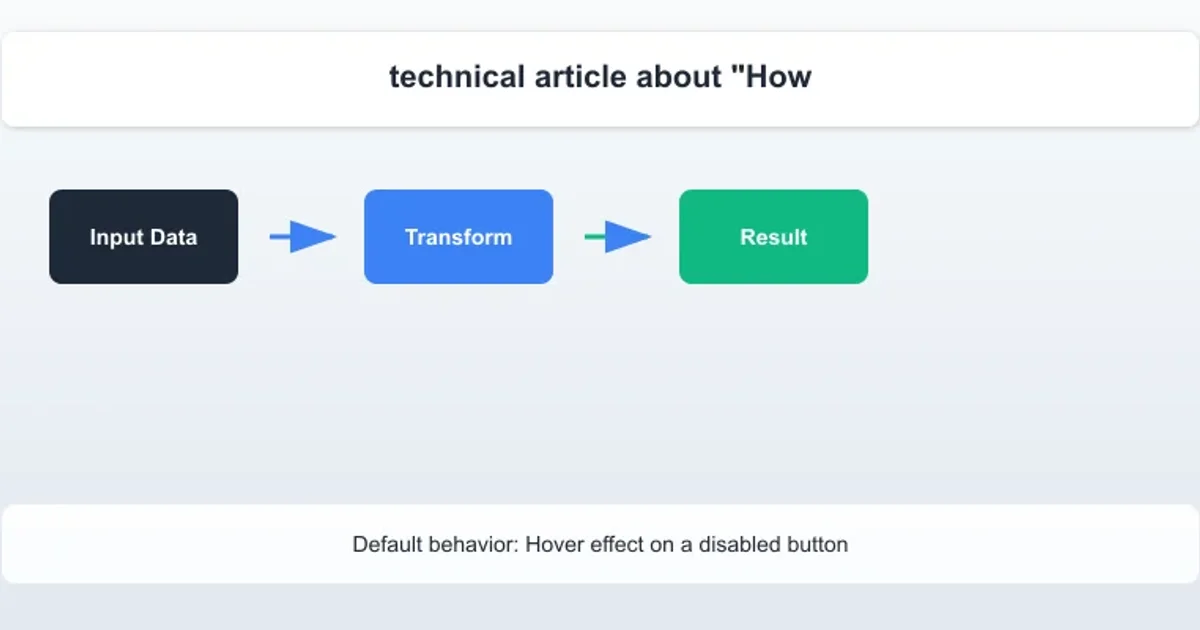How can I make a CSS Hover not work if a button is disabled?
Categories:
Preventing CSS Hover Effects on Disabled Buttons

Learn how to effectively disable CSS hover styles on buttons when they are in a disabled state, ensuring a consistent and intuitive user experience.
When designing user interfaces, it's common to apply visual feedback to interactive elements like buttons, often using CSS hover effects. However, these effects can become confusing or misleading when a button is disabled. A disabled button should clearly communicate that it's not interactive, and a lingering hover effect contradicts this message. This article explores various CSS techniques to ensure that hover styles are correctly suppressed when a button is in a disabled state, enhancing usability and accessibility.
Understanding the Problem: Default Behavior
By default, CSS hover styles will still apply to a disabled button unless explicitly overridden. This is because the :hover pseudo-class checks if the mouse cursor is over the element, regardless of its interactive state. While the button won't trigger an action, the visual change on hover can suggest interactivity, leading to a poor user experience. Users might repeatedly try to click a button that appears interactive but isn't, causing frustration.

Default behavior: Hover effect on a disabled button
Solution 1: Using the :disabled Pseudo-class
The most straightforward and semantically correct way to prevent hover effects on disabled buttons is to use the :disabled pseudo-class in conjunction with :hover. This allows you to specifically target a button that is both disabled and being hovered over, and then reset or override any unwanted hover styles.
/* Default button styles */
button {
background-color: #007bff;
color: white;
padding: 10px 20px;
border: none;
border-radius: 5px;
cursor: pointer;
transition: background-color 0.3s ease;
}
/* Hover effect for enabled buttons */
button:not(:disabled):hover {
background-color: #0056b3;
}
/* Styles for disabled buttons */
button:disabled {
background-color: #cccccc;
color: #666666;
cursor: not-allowed;
/* Ensure no hover effect */
pointer-events: none; /* Optional: Prevents any mouse events */
}
/* Explicitly remove hover effects for disabled buttons (redundant with pointer-events: none, but good for clarity) */
button:disabled:hover {
background-color: #cccccc; /* Revert to disabled background */
color: #666666; /* Revert to disabled text color */
box-shadow: none; /* Remove any shadow effects */
transform: none; /* Remove any transform effects */
}
CSS to prevent hover effects using :not(:disabled) and :disabled:hover
pointer-events: none; on a disabled button is a robust way to prevent all mouse events, including hover, click, and drag. This is often the most effective single property to ensure no interaction with a disabled element.Solution 2: Wrapping the Button (Less Ideal)
While not as semantically clean as using :disabled, another approach involves wrapping the button in a container element and applying the pointer-events: none; to the wrapper when the button is disabled. This can be useful in scenarios where you need to disable the button but still want to show a tooltip on hover over the wrapper, for example, explaining why the button is disabled. However, for simply disabling hover effects, the :disabled pseudo-class is preferred.
<!-- HTML Structure -->
<div class="button-wrapper">
<button type="submit" disabled>Submit</button>
</div>
<div class="button-wrapper enabled">
<button type="submit">Submit</button>
</div>
HTML structure with a button wrapper
/* Wrapper styles */
.button-wrapper {
display: inline-block; /* Important for pointer-events to work correctly */
}
.button-wrapper:has(button:disabled) {
pointer-events: none;
}
/* Button styles */
.button-wrapper button {
background-color: #007bff;
color: white;
padding: 10px 20px;
border: none;
border-radius: 5px;
cursor: pointer;
transition: background-color 0.3s ease;
}
.button-wrapper button:hover {
background-color: #0056b3;
}
.button-wrapper button:disabled {
background-color: #cccccc;
color: #666666;
cursor: not-allowed;
}
CSS using a wrapper and :has() to disable hover
:has() pseudo-class is relatively new and might not be supported in older browsers. Always check browser compatibility if you plan to use it.Accessibility Considerations
Beyond visual cues, ensuring accessibility for disabled buttons is crucial. Screen readers will typically announce a button as 'disabled' when the disabled attribute is present. By correctly suppressing hover effects, you reinforce this state visually, providing a more consistent experience for all users. Avoid relying solely on pointer-events: none; without the disabled attribute, as this can create inaccessible elements that appear disabled but are not semantically recognized as such by assistive technologies.
1. Apply the disabled attribute to your HTML button element.
This is the foundational step for both visual and semantic disabling.
2. Define base styles for your button.
Set default background-color, color, padding, etc.
3. Define hover styles using :not(:disabled):hover.
This ensures hover effects only apply to enabled buttons.
4. Define disabled styles using :disabled.
Set distinct background-color, color, and cursor: not-allowed;.
5. Add pointer-events: none; to the :disabled rule.
This is the most effective way to prevent all mouse interactions, including hover.